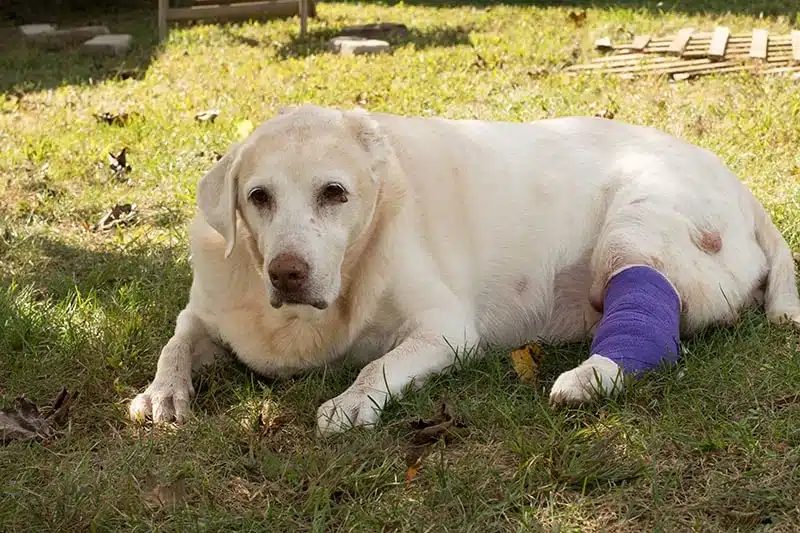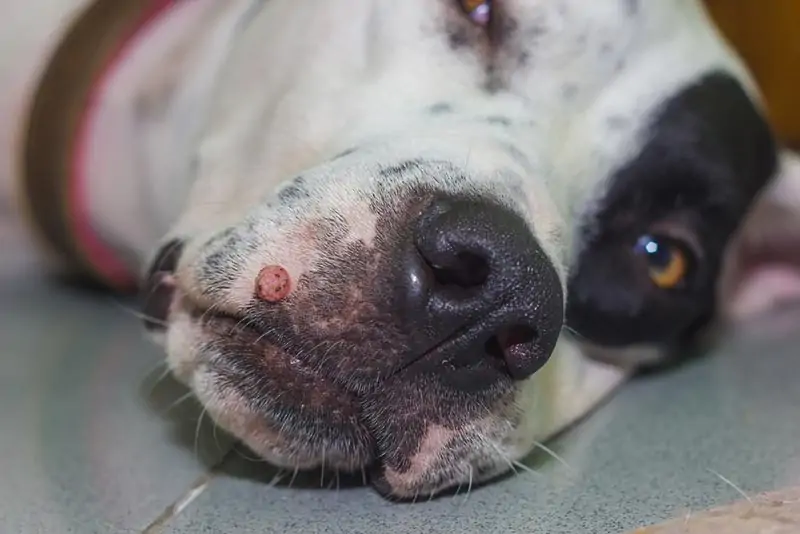Lumps and bumps on (or in) a dog can be a major concern to their pet-owning parent. With about 25% of dogs developing neoplasia in their lifetime, and about 50% of dogs over 10 years old having cancer, the odds of you seeing a tumor on your dog at some point are high.1
What are some common types of tumors in a dog? If a dog develops these, what other signs might you expect to accompany it? We’ll discuss this as well as the general diagnostic and treatment elements below.

Tumor Types
Tumor, neoplasm, cancer; what do all these words mean, exactly? Providing definitions of pertinent terms will be helpful as we continue.
Neoplasia is an abnormal mass of cells in the body that divide more frequently than they should or do not die when they should. The growth or physical appearance of neoplasia itself is often referred to as a neoplasm or tumor. The tumor itself can be either benign or malignant.
A benign tumor usually grows slower and typically does not invade nearby surrounding tissue or spread (metastasize) throughout the body. In contrast, a malignant tumor may behave erratically. The cells may grow rapidly, spread to nearby tissues, and metastasize to other areas of the body. The true definition of cancer is that it is a malignant neoplasm.

The 10 Common Types of Dog Tumors
While there are numerous different types of neoplasms that can arise all over a dog’s body, these are a select few of some of the more common or well-known tumors.
1. Mast Cell Tumor

This type of malignant tumor involves mast cells which are immune cells that are involved with allergic reactions. They most frequently affect the skin but can affect other organs as well. Because they can vary widely in appearance, it is important to sample (see diagnosis below) which, depending on how aggressive the tumor is, will dictate treatment.
2. Osteosarcoma
This tumor starts in bone cells. It is known to be malignant and very aggressive, by not only destroying the affected area of bone but also very likely to metastasize. When present in the limbs, physically this tumor type is characterized by pain, swelling, and limping. It tends to affect larger dog breeds, most frequently in specific areas of the limbs.
3. Melanoma
These tumors come from pigment-producing cells called melanocytes. They may be either benign and only cause problems around the tumor, or malignant and spread to other parts of the body such as the lymph nodes and/or lungs. Most often this tumor is in the mouth (oral melanoma) but other common sites include the skin, nail bed, or eye.
4. Hemangiosarcoma
This tumor comes about from cells that form blood vessels. It is a very aggressive and malignant cancer with a high likelihood of metastasis to other internal organs, including the lungs. Areas that are the most common origin sites are the spleen, liver, skin, or right upper side of the heart (right atrium).
5. Lipoma

This is a benign tumor from fat cells that is extremely common. It will usually occur in the subcutaneous (area under a dog’s skin before their muscle) fat cells of dogs. While they can be a cosmetic issue for some owners, they may also continue to grow very big or may be in a problematic area (such as underneath a limb) which may impede mobility.
6. Lymphoma
This type of cancer is also referred to as lymphosarcoma and is a very commonly diagnosed cancer in dogs. It involves lymphocytes, a type of white blood cell that helps with the immune system, and lymphoid tissue, which is present in many places including the lymph nodes, bone marrow, etc. There are many different forms of lymphoma, but the most common one causes enlarged lymph nodes.
The good news is that with certain types of lymphoma, an affected dog can respond well to chemotherapy to achieve remission.
7. Papilloma

A benign tumor caused by the papillomavirus. These viral warts are contagious only amongst dogs and are often centralized in or around the mouth, but they can also appear elsewhere such as on the feet. When seen, they often look like bumps that have a hard outer surface that looks like cauliflower.
Young dogs with more immature immune systems or those who are immunocompromised are the most likely to be affected, but surprisingly, these growths will typically go away on their own after a few weeks to a few months!
8. Mammary Tumor
This is most commonly seen in mammary tissue in female dogs that are unspayed or that were spayed after their first heat cycle. In dogs, the mammary chain consists of five pairs of glands on the left and right underside that go from the area of the armpit to the groin. The tumor can vary in size, shape, and number, and can occur as a single tumor or multiple within one or many glands.
These tumors can be benign or malignant and may even change from benign to malignant over time.
9. Histiocytoma

This benign fast-growing skin tumor is more likely to be present in younger dogs that are less than 3 years old. While they can become ulcerated or infected, which can be problematic, most of the time, these growths go away on their own in less than 3 months.
10. Sebaceous Gland Tumor
There are several different kinds of these tumors, but these are typically benign and appear as small, pea-sized growths. The tumors come from the sebaceous glands in the skin, which are responsible for producing oil to help moisturize and protect the skin. These growths can appear anywhere on the body, often in great numbers, and typically affect older dogs.

Signs of a Tumor
Each type of cancer may have unique characteristic signs that are present.
- Visible swelling, growth, or tumor
- Distended abdomen
- Swollen lymph nodes throughout the body
- Changes in weight
- Not wanting to eat
- Lethargy
- Difficulty breathing
- Coughing
- Ongoing vomiting or diarrhea
- Pale gums
- Limping
- Pain
If you’re concerned about your pet’s well-being, we recommend you contact a veterinarian.
If you need to speak with a vet but can't get to one, head over to PangoVet. It's our online service where you can talk to a vet online and get the advice you need for your pet — all at an affordable price!
Diagnosis
A thorough history and physical exam provide much information to a veterinarian, but a definitive diagnosis for a growth cannot be obtained by physical appearance or feeling the consistency of a tumor alone. The only way to know for sure what it is, is to sample and look at the cells closely to determine the tumor type and its characteristics.
This is often done with cytology, either via fine needle aspirate (FNA) and/or biopsy by obtaining cells of the tumor to evaluate under the microscope. An FNA is where a needle is inserted into the tumor to get a small sampling of cells; if on an internal organ such as the liver, an ultrasound to guide the sampling may be needed.
On the other hand, a biopsy may need sedation or anesthesia but can provide even more information. It may be incisional (cutting out a small amount of tumor which provides more cells than an FNA sample) or excisional (where all the tumor is removed). Once a cytology sample is obtained, it is commonly sent to a pathologist to be evaluated for more information such as the type of tumor, if it is benign or malignant, etc.
Additionally, bloodwork and other imaging such as with radiographs and/or ultrasound, as well as additional cell samplings such as of lymph nodes, etc. may also be helpful in determining a more full picture of whether the tumor is local or has spread as well as a dog’s overall health. Sometimes, a CT or MRI may be recommended. In addition, a veterinary oncologist (a veterinarian who specializes in the study and treatment of cancer) may be consulted by your veterinarian, or they may even be recommended to you for referral depending on the case.

Treatment
While there are no guarantees even with treatment, there can be success for dogs with tumors. An important point is that early detection and treatment can also be more likely to successfully prolong the life of your dog.
Each type of tumor has its own recommended course of treatment, and each treatment plan will be influenced by many factors. Some of these factors include what type of cancer is present, the stage (how advanced/large the tumor is and the depth of spread to other areas in the body), the type (chance for response to therapy), as well as how much a pet parent wants to or is able to pursue treatment. Sometimes, more than one treatment may be recommended.
- Surgery
- Chemotherapy
- Radiation
- Immunotherapy
- Cryotherapy (freezing)
- Hyperthermia (heating)
One major difference regarding chemotherapy between people and animals is that animals’ quality of life during chemotherapy is actually quite good! In fact, most don’t typically have negative effects and if they do, the majority of those are mild. In fact, fewer than 25% of animals will have minor side effects a few days after a chemotherapy treatment, and less than 5% have severe side effects. Most that do end up having minor reactions consist of mild lethargy or gastrointestinal signs within a few days after treatment that can be very manageable.
Depending on the type of neoplasia, a cure may be possible, or, alternatively, management to limit the spread and allow your dog to have as long and comfortable a life as possible. In needed cases, palliative treatment may be utilized to help a dog have a comfortable, good quality of life for the remainder of their time. While a difficult decision to make, euthanasia may also be an option if there is a poor prognosis with a dog’s particular type of cancer, if treatment is not an option, or if a dog’s quality of life is poor and they are suffering.

Conclusion
If your beloved pet dog develops a visible growth or may be showing vague, non-specific signs and are not acting like themselves, your best bet is to have them promptly evaluated by their veterinarian. Should a tumor be suspected or confirmed, your dog’s doctor will be your source for the next steps to take.
See Also:
Featured Image Credit: Nestor Rizhniak, Shutterstock


















